 Register on the forum now to remove ALL ads + popups + get access to tons of hidden content for members only!
Register on the forum now to remove ALL ads + popups + get access to tons of hidden content for members only!
|
||||||||
 Best Porn Sites Best Porn Sites
|
Live Sex | Register | FAQ | Members List | Calendar | Mark Forums Read |
| Politics, Current Affairs, Religion Threads Post here for all Politics, Current Affairs, Religion Threads |
 |
|
|
Thread Tools | Display Modes |
|
|
#1681 |
|
Vintage Member
Join Date: Jun 2011
Posts: 6,814
Thanks: 26,898
Thanked 80,770 Times in 6,813 Posts
           |
Just read an interesting article in Smithsonian magazine about Gallipoli. It seems the Turks are rewriting the history, downplaying Kemal and nationalism and casting it as a victory for Islam. When archeologists working in the Turkish trenches discovered beer bottles, there was consternation. The Turks insisted that their soldiers drank tea, not beer and that the bottles were from the German advisors!
|
|
|

|
| The Following 20 Users Say Thank You to Ennath For This Useful Post: |
|
|
#1682 |
|
Super Moderator
Join Date: Jan 2009
Location: England
Posts: 26,237
Thanks: 162,392
Thanked 278,475 Times in 26,182 Posts
           |
Quote:
Originally Posted by Trintron  On another subject, Austria-Hungry was the least prepared for WW1 and most old fashion of all the armies in Europe, they thought they were equal to the Germans and Russians. As unprepared for the war as Russia was, they were still better than the Austro-Hungarians. Yes, the Typhus epidemic that swept through the Balkans did not help things, if there was no epidemic, the Serbians would have held their own against the Austro-Hungarians. The dubious accolade of least prepared probably belongs to the Romanian army in 1916.  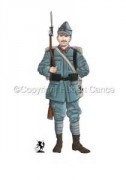  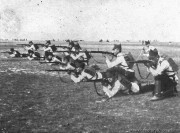 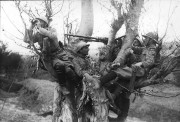 Romania was not a major power, though she had an army of over 500,000 men and wasn't a minnow. Her geography placed her in between Austro-Hungarian and Russian forces. In the beginning she opted for neutrality; her territory was ripe to be the cockpit in which foreign forces, allied and enemy, would fight it out, to the detriment of the Romanian people. There was an 1883 treaty with Germany in which each side promised to support the other if either was attacked (it was soon after Romania first freed herself from the Ottomans in 1877 but was actually a precaution against Russia). Germany attacked Russian and France, not the other way round, and Romania declined to support her. The truth was that Romania wanted to take Transylvania from Austria-Hungary and her her strategy was to wait until a propitious opportunity to attack Austria Hungary. Probably her best option would have been to support Serbia from the beginning. Austria-Hungary's armies in Serbia in 1914 performed very badly and a flank attack from Romania would have been disastrous. Though soundly beaten by Germany at Tannenburg, the Russians did better in Silesia against Austria-Hungary and Austria-Hungary was very over-extended, fighting her own war of two fronts. A strike by Romania into Hungary would have endangered the rear of Austrian forces in Serbia and very likely forced them to retreat. It might have changed Bulgaria's decisions. But actually Romania's military was in a rotten state in 1914. The defence minister, Colonel Rodeanu, reported to the Romanian cabinet in September 1914: Quote: We have 434,000 guns, of three different systems, some of them very old, model 1879, with slow-firing. Taking into account the need to keep as a backup stock about 100,000, we have 334,000 guns left to arm 43 divisions of about 12,000 men each. That would correspond to an army of 516,000 soldiers, even though, judging by the size of Romania‘s population, we could have more than 600,000. …Our field artillery include a total of 1,231 cannons, of which only 787 modern, with quick firing, the rest being old cannons. Mountain artillery is greatly reduced, 52 pieces of which 36 very old, md.1863. Heavy field artillery is quasi non-existent. That's enough rifles for 60% of the infantry: 40% of the infantry not even armed with a sharp stick. It hadn't improved much by 1916 either. Romania joined the war in August 1916, at a moment not well timed. Serbia was conquered and the Serbian army and a lot of Serbia's people were in exile in Italy. Support which could have been had in 1914-5 was gone, as was Romania's big chance to strike a strategic blow by rescuing Serbia. Bulgaria was in, on the Austrian side; so Romania was faced by hostile forces on three sides of the box. There really wasn't anything advantageous about the timing at all. Romania declared war on Austria-Hungary only; but the Germans were quick to support ther ally. Without access to the Ploesti oilfields, Germany would quickly run out of petrol and oil, and these were already indispensible war commodities. So German forces under Falkenheyn attacking from Hungary and Serbia and Mackensen attacking from Bulgaria intervened heavily and Romania was quickly driven out of Transylvania, where she invaded. Three of her four Armies defended the Carpathian mountain passes for over two months, but she only had one on her Bulgarian borders. By September. only 4 weeks into the war, she was retreating on her own soil. Bucharest fell in December 1916 and by 1917 only Moldova remained, where Romanian forces were only a component within Russian led armies. Romania joining the war on the Allied side turned out to be a huge disaster for the Allied side. By January 1917, Russia was defending with over 30 Russian divisions a front in Moldavia and Bessarabia which had previously been shielded by a neutral country called Romania. She was also completely re-equipping dozens of shattered and demoralised Romanian divisions which had been very badly led by their own army commands and were now better off under Russian command. In the short run, that is. When Russia dropped out of the war after the Bolshevik Revolution, Romanian divisions found themselves side by side with Russian divisions whose soldiers had made peace, and they had no alternative but to capitulate as well.
__________________
To view links or images in signatures your post count must be 0 or greater. You currently have 0 posts. |
|
|

|
| The Following 21 Users Say Thank You to scoundrel For This Useful Post: |
|
|
#1683 |
|
Member
Join Date: Feb 2009
Posts: 97
Thanks: 785
Thanked 1,351 Times in 97 Posts
           |
We can add another item to the list...
I am picking only one specific campaign, the Ottoman Caucasus Campaign of 1915. The Ottoman Army personally led by Enver Pasha - Ottoman Empire Minister of War, during the Ottoman invasion of the Caucasus Mountains in the winter of 1915. The Ottoman Empire started the invasion of the Caucasus with the goal of recovering lost territory taken by the Russians in a previous war. Most of the Ottoman Army was never equipped properly for a winter campaign and most of the Ottoman troops died from freezing to death and not in combat. The Ottoman Army never got that far, they reached the out skirts of Kars before they had to retreat back to Sarikamish near the border of Russia and the Ottoman Empire. The Ottoman Empire's invading army looked impressive on paper, but was not prepared for the Environmental conditions nor was it very well equipped for war. The Russians for their part viewed this as a secondary front, their main front was the Eastern Front against the Germans and Austrians. Enver Pascha for his part blamed the Armenians for the failure, he did not command a military campaign of this sort again, though he did continue to command troops in the Ottoman Empire. |
|
|

|
| The Following 18 Users Say Thank You to Trintron For This Useful Post: |
|
|
#1684 | |
|
Super Moderator
Join Date: Jan 2009
Location: England
Posts: 26,237
Thanks: 162,392
Thanked 278,475 Times in 26,182 Posts
           |
Quote:
He dabbled in motor racing after the war but then concentrated on aviation, his first love, becoming owner of a manufacturing and aircraft repair works in Erfurt. Inevitably, the Nazis took an interest in his business, which was strategically useful to Goering's rebuilding Luftwaffe. Goering wanted him to join the NSDAP but he declined; then, in exchange for proferred government contracts, Goering (who was a total thief among other things) wanted to be given a major shareholding in the company Jacobs had built up. Jacobs moved his business to Holland, lock stock and barrel, to be out of Goering's reach, but of course Holland was invaded in 1940 and rather than cooperate with Goering or take the punishment for not doing so, he went into hiding before escaping from Holland. What happened after that I don't know. He mitigated the slowness of his Triplane by using captured Allied Clerget engines. Despite the name they were probably mostly British, because Britain was the main adopter of the Clerget, particularly for the Sopwith Camel, and the Clerget was made in Britain under licence. The Clerget had 140hp compared with the 110hp of the standard Oberusel engine, so it must have improved the speed and climbing attributes of Jacob's DR1. But of course there was no German supplier and so it could only be sourced from shot down Allied machines, which no doubt is why Leutnant Jacobs paid a crate of champagne per unit. Strange to think that Mr Jacobs was still alive in 1978; I could have met him. But in 1978 I would not have appreciated the unusual knowledge and expereince of the man or known what to ask him. Hell, I kick myself now for not asking a lot more of my grandmother about WW1, which she lived through. 
__________________
To view links or images in signatures your post count must be 0 or greater. You currently have 0 posts. |
|
|
|

|
| The Following 19 Users Say Thank You to scoundrel For This Useful Post: |
|
|
#1685 | |
|
Moderator
Join Date: Jul 2007
Location: Upper left corner
Posts: 7,205
Thanks: 47,956
Thanked 83,444 Times in 7,199 Posts
           |
Quote:
People smirked when George Bush talked about "bringing freedom and democracy" to the Middle East, but I think he probably genuinely believed it. And I know that Woodrow Wilson truly believed it. His religious faith was accompanied by an understanding of how this morality was supposed to work in the affairs of nations. When you're as jaded as I think most of us are, it's hard to understand the perspective of the more naive. The irony of it all is that neither side in the First World War shared Wilson's aims-- he sought the end of empire and self determination for colonies. That wasn't the British Empire's war aim any more than it was the German, the Austro-Hungarian, or the Russian. In that sense, World War One has the strangest mismatch of allies. |
|
|
|

|
| The Following 16 Users Say Thank You to deepsepia For This Useful Post: |
|
|
#1686 | |
|
Admirer of MaxJoker [RIP]
Join Date: Dec 2012
Location: Somewhere in the Grand Duchy of Luxembourg
Posts: 1,830
Thanks: 1,709,711
Thanked 30,501 Times in 1,805 Posts
           |
Concerning the life of First World War flying ace Josef Jacobs after 1940 ...
I've done a quick (and therefore quite "rough"  ) research about the gaps in his biography ... ) research about the gaps in his biography ...For example, none of the articles about Josef Jacobs in the English, French and German Wikipedia [<<< the underlined parts are clickable links!  ] gives detailed/valuable information (= information is only valuable with citation!) about the time after 1940 until 1978. ] gives detailed/valuable information (= information is only valuable with citation!) about the time after 1940 until 1978.The English and French Wiki articles mention that Jacobs became president of The German Bobsleigh Society (< when? and how long? Citation needed!). The German Wiki article mentions (also without a real quote!  ) that Jacobs had (probably?!) lived on public welfare ["Sozialhilfe"] right before his death. ) that Jacobs had (probably?!) lived on public welfare ["Sozialhilfe"] right before his death.  Addition [10-02-2015]: A Google search [search string = "Josef Jacobs" pilot biography] gave only poor results, but showed a link to a page with posts from the year 2000(!!) and (on the bottom of this page) some closer information about Josef's life after 1945 (without any citation  ). Note that the poster was a certain Gary Jacobs = a distant relative or descendant of Josef? ). Note that the poster was a certain Gary Jacobs = a distant relative or descendant of Josef?  Quote:
 Provided that you have not yet(??) seen a picture of Josef Jacobs in his later years ... just to give you an impression of the guy you've missed to meet in 1978 ... here's a pic dating from the 70s where he is wearing his Pour le Merite. 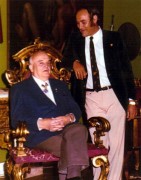
__________________
FUBAR can (also) mean that YOU live in the deepest forest ... with a poorer bandwidth than the Apollo 13 crew ever had ... while YOUR government's eggheads in YOUR capital enjoy surfing with 150MB/sec or more! Of course, these numbskulls never watch internet porn! To view links or images in signatures your post count must be 0 or greater. You currently have 0 posts. They can afford young "Bunga Bunga" chicks. To view links or images in signatures your post count must be 0 or greater. You currently have 0 posts. Last edited by Tester2010; February 10th, 2015 at 05:37 PM.. Reason: Addition |
|
|
|

|
| The Following 15 Users Say Thank You to Tester2010 For This Useful Post: |
|
|
#1687 |
|
Veteran Member
Join Date: Apr 2009
Location: Here and there
Posts: 4,029
Thanks: 102,514
Thanked 93,973 Times in 4,024 Posts
           |
A couple of WW1-related stories I saw in the news over the last week or so.
Firstly, the Victoria Cross awarded in 1918 to Private James Towers is to be sold at auction later this month. Towers' VC was originally sold by the family after his death in 1977, but the private collector who currently owns it has now decided to sell- It's expected to fetch between £130k-£160k, and prolific VC collector Lord Ashcroft is one of the likely buyers. On 6th October 1918, 2nd Battalion Scottish Rifles (The Cameronians) were dug in along the line of a railway embankment at Mericourt, near Lens in France. The position was under considerable pressure from a German advance, and eventually an order to withdraw was given. However there was a problem- a forward platoon from one company had got isolated between the two German lines of advance and was cut off from the rest of the battalion. With no other line of communication open, it was necessary to send a runner out into No-Man's land to try to relay the withdrawal order to the isolated company. Five attempts were made- all failed, as the volunteer carrying the message fell victim to German fire. As the situation became more desperate, and having seen five of his comrades killed in their efforts to deliver the message, James Towers volunteered to make a sixth attempt. Under heavy fire, he went forward, making his way from shell-hole to shell-hole, and through the wire- On the way he came across the body of one of those killed in an earlier attempt- Private Frank Dunlop, one of his best friends. Reaching the top of the embankment, Towers was aware that the Germans had the area well-covered, and that his best chance of survival was to take them by surprise. Jumping over the bank, he practically landed on top of a German machine-gun position on the far side, but having caught the Germans off-guard, was able to get clear before they were able to bring the gun to bear and open fire on him. Finally reaching the cut-off platoon, he stayed with them overnight, before using his knowledge of the location of the German MG positions to guide the platoon back to the British lines the following morning. His VC was gazetted in January 1919. He later explained his actions- 'I joined up as a youngster for a bit of fun, but it didn't turn out like that. We were young men made old before our time. I felt then, that I had to go to the help of these lads, after all, they were my pals. I had been in worse situations than that before and no medals were awarded, but that's how it was'. |
|
|

|
| The Following 16 Users Say Thank You to Historian For This Useful Post: |
|
|
#1688 |
|
Veteran Member
Join Date: Apr 2009
Location: Here and there
Posts: 4,029
Thanks: 102,514
Thanked 93,973 Times in 4,024 Posts
           |
The second story that caught my eye was a piece about a ship I'd never heard of, which is part of the National Museum of the Royal Navy and will see her centenary this year- HMS M.33
M.33 is a monitor, designed to get in close to the shore and shell targets on land. To this end, she's a little ship of less than 600 tons, with a shallow draft, and over-armed in relation to her size by an almost comical degree - 2x BL 6-inch MkXII guns, weapons normally used on light cruisers, or as secondary armament on battleships of the period, plus a 6-pounder Hotchkiss gun and 2 machine guns for close-range defence, mounted on a ship little more than 175 feet long. Launched in May 1915, she saw her first action at Gallipoli. After WW1, she was used as a minelaying training ship, a refuelling hulk and a floating workshop, eventually passing into the hands of Hampshire County Council's Museums department for preservation. Now part of the National Museum of the Royal Navy, one of only a handful of WW1 RN warships to survive, and the only veteran of the Gallipoli campaign, she sits in a dry dock at Portsmouth adjacent to HMS Victory, and is planned to open to the public later this year after a long restoration to original WW1 configuration http://www3.hants.gov.uk/m33.htm http://www.nmrn.org.uk/exhibitions-p...onitor-hms-m33 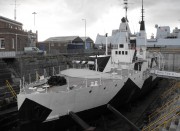 e eLast edited by Historian; March 7th, 2015 at 06:10 AM.. Reason: added details and links |
|
|

|
| The Following 19 Users Say Thank You to Historian For This Useful Post: |
|
|
#1689 |
|
Veteran Member
Join Date: Apr 2014
Location: NZ
Posts: 4,035
Thanks: 70,712
Thanked 40,941 Times in 4,026 Posts
           |
Pales into insignificance compared to the two Marshal Ney class monitors with a twin 15" turret on a displacement of only 6500 tonnes and a draught of just over 10-ft...launched in 1915....and the Lord Clive and General Wolfe monitors mounting an 18"
http://en.wikipedia.org/wiki/Marshal_Ney-class_monitor http://en.wikipedia.org/wiki/HMS_Lord_Clive_%281915%29 http://en.wikipedia.org/wiki/HMS_Gen...lfe_%281915%29 An interesting snippet was that the HMS General Wolfe achieved the longest range gunnery engagement for the RN, at a range of 36,000 yards, with the 18", at a target at Snaeskerke in Belgium.......vastly outranging the record for a gunnery hit from one ship on another-which is pretty much a tie between HMS Warspite's hit on the Italian battleship Guilio, and SMS Scharnhorst's hit on HMS Glorious-both at ~26,000 yards |
|
|

|
| The Following 14 Users Say Thank You to Dr Pepper For This Useful Post: |
|
|
#1690 |
|
Super Moderator
Join Date: Jan 2009
Location: England
Posts: 26,237
Thanks: 162,392
Thanked 278,475 Times in 26,182 Posts
           |
 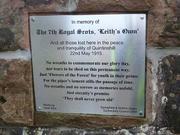   This weekend there are several merorial services being held to mark the 100th anniversary of Britain's worst ever rail disaster, the Quintinshill rail crash. It involved five trains, one of which was a troop train carrying a battalion of the Royal Scottish Borderers on its way to be shipped out from Liverpool to Gallipoli. Quintinshill isn't even a genuine place; it is merely a signal station and a junction with two sidings where trains stand aside so that the express can overtake them. The nearest human habitation is Gretna, the border town between Scotland and the English Lake District county of Cumbria; that is about a mile south of Quintinshill. The two signalmen on duty, who afterwards never could explain why they did so, gave the green signal to the troop train even though a local passenger train was being shunted on the main line, right before their very eyes. The fireman of the passenger train was supposed to get off, go to the signal box and personally see to it that they did not issue a green signal as long as his train was blocking the main line; that was a legal requirement for every train which was blocking a main line. He did not do this. He did get off, go to the signalbox and sign the register; but he did not see that the signallers had given the green signal; it can only be that he reminded them his train was there but took it on good faith that they would act like reasonable men and look after his train and his people. There were a number of other rules and procedures specifically designed to make sure an accident such as Quintinshill simply would not be possible, and not one of them was obeyed; had even one of them been obeyed, the accident would not have happened. I have borrowed from Wikipedia a simple and extremely effective (and chilling) little gif which shows exactly what happened. http://upload.wikimedia.org/wikipedi...nimation_1.gif The two goods trains were passive, but relevant, because their presence explains why the local service was being shunted on the main line and not on either of the sidings, as was preferable. Basically, the junction was just a little bit too busy, and the signallers were not sufficiently agile of mind to choreograph the dance so than no one trod on anyone else's feet. It was very early and the shift was being changed; the wikipedia article explains how this too was an issue, with the two signalmen flouting regulations to give themselves an easier life. It is often senior management who are to blame for unsafe working practices, but in this specific case, it was the humble employees who were breaking the rules to suit themselves; the senior management should no doubt have been enforcing by physically inspecting their signal boxs randomly to ensure that the right people were there at the right times and that the logs were not being falsified. The terrible truth is that no one really knows exactly how many people died in this awful disaster. The mortal remains of 228 people were dfinitively found; four of them, thought to be children, were never identified and lie in a paupers grave in Glasgow, afterwards commemrated by Glasgow City Council with a marble headstone so people would remember them. The troops were from from the 1sth Battalion of the 7th (Leith) Regiment of the Royal Scottish Borderers; territorials and recruited from all over the Scottish border counties, men local to the place where the accident happened. This was in 1915 and the train carraiges were gas-lit, so the smash was followed by a ferocious fire which consumed the carraiges and hundreds of soldiers trapped inside them. Though never officially acknowledged, it is widely accepted that a number of soldiers who could not be rescued were shot through the walls of the carraiges by their officers, to spare them from being burned alive. Quite a few who survived did so because their comrades crawled underneath burning carraiges and amputated trapped arms and feet without anaesthetic and using any sharp knife, bayonet or saw that happened to be available, just so that they could pull the poor bastard to safety. The muster rolls of the battalion were lost in the fire, and the fire was so extreme that some bodies of men known to have been there were never found. So the casualty list had to be compilled by interviewing all the survivng soldiers and crosschecking their accounts to glean the names of the missing men. It may well be that one or two men were killed, no one left alive to say that they had been there, and so got missed on the roll of the dead. The known tally of the Regimental dead is 214 soldiers; 14 civilians also died. This cannot possibly have been the only such tragedy in WW1, a war in which millions of soldiers all over Europe had to mobilised extremely quickly on railways intended for peacetime traffic volumes.
__________________
To view links or images in signatures your post count must be 0 or greater. You currently have 0 posts. |
|
|

|
| The Following 14 Users Say Thank You to scoundrel For This Useful Post: |
 |
| Thread Tools | |
| Display Modes | |
|
|